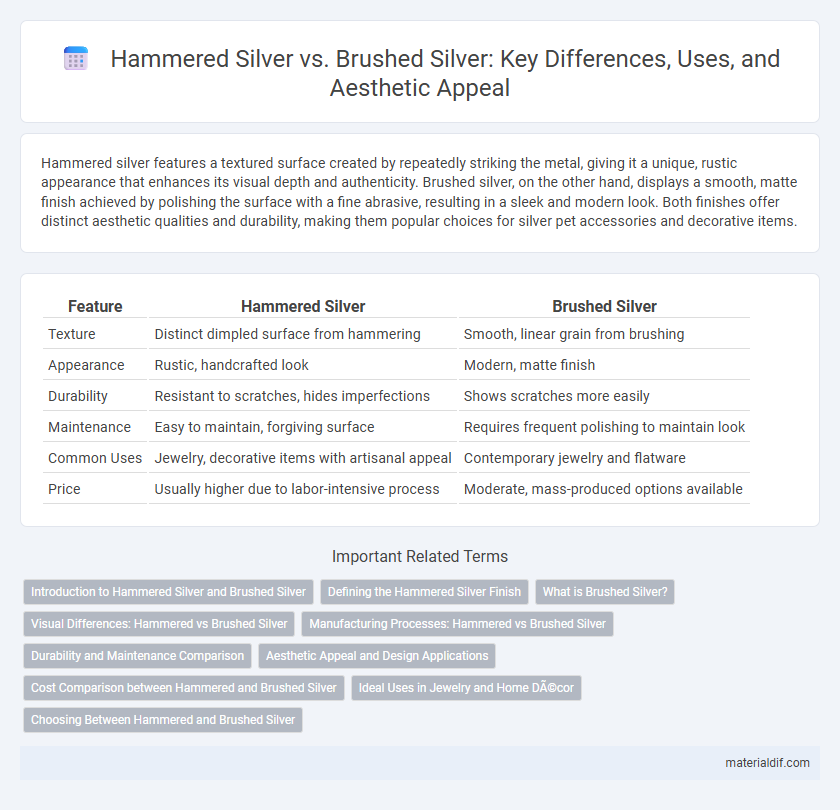Hammered silver features a textured surface created by repeatedly striking the metal, giving it a unique, rustic appearance that enhances its visual depth and authenticity. Brushed silver, on the other hand, displays a smooth, matte finish achieved by polishing the surface with a fine abrasive, resulting in a sleek and modern look. Both finishes offer distinct aesthetic qualities and durability, making them popular choices for silver pet accessories and decorative items.
Table of Comparison
| Feature | Hammered Silver | Brushed Silver |
|---|---|---|
| Texture | Distinct dimpled surface from hammering | Smooth, linear grain from brushing |
| Appearance | Rustic, handcrafted look | Modern, matte finish |
| Durability | Resistant to scratches, hides imperfections | Shows scratches more easily |
| Maintenance | Easy to maintain, forgiving surface | Requires frequent polishing to maintain look |
| Common Uses | Jewelry, decorative items with artisanal appeal | Contemporary jewelry and flatware |
| Price | Usually higher due to labor-intensive process | Moderate, mass-produced options available |
Introduction to Hammered Silver and Brushed Silver
Hammered silver features a textured surface created by indenting the metal with a hammer, giving it a rustic and handcrafted appearance that enhances light reflection and depth. Brushed silver, in contrast, has a smooth, matte finish achieved by rubbing the metal with an abrasive material, resulting in a subtle, non-reflective sheen that highlights a modern and sleek aesthetic. These distinct surface treatments influence the visual appeal and tactile experience of silver jewelry and decor.
Defining the Hammered Silver Finish
The hammered silver finish is characterized by small indentations created by repeatedly striking the metal with a hammer, resulting in a textured, dimpled surface that reflects light in unique patterns. This handcrafted technique enhances the durability of silver items and adds a rustic, artisanal appeal compared to the smooth and matte appearance of brushed silver. Hammered silver is commonly used in jewelry, tableware, and decorative pieces to evoke a vintage or handcrafted aesthetic.
What is Brushed Silver?
Brushed silver is a metal finish achieved by polishing silver with a fine-bristled brush, creating a textured surface with subtle, linear grain patterns. This technique reduces the reflective shine typical of polished silver, giving it a matte appearance that resists fingerprints and scratches. Commonly used in jewelry and flatware, brushed silver offers a modern, understated aesthetic while maintaining the durability of sterling silver.
Visual Differences: Hammered vs Brushed Silver
Hammered silver features a textured surface with small indentations that create a reflective, dimpled effect, enhancing its handcrafted and rustic appeal. Brushed silver displays fine, linear scratches in a unidirectional pattern, resulting in a matte finish with subtle sheen and a modern, sleek look. Both finishes offer distinct visual characteristics that influence the overall aesthetic of silver jewelry, decor, and tableware.
Manufacturing Processes: Hammered vs Brushed Silver
Hammered silver is created by manually striking the metal surface with a specialized hammer to produce textured, dimpled patterns, enhancing its reflective qualities and visual depth. Brushed silver undergoes a mechanical abrasion process using an abrasive belt or brush, yielding a smooth, matte finish with fine directional lines that reduce shine and highlight the metal's natural luster. Both manufacturing processes impact the durability and aesthetic appeal of silver items, with hammered silver emphasizing artisanal craftsmanship and brushed silver offering a contemporary, subdued elegance.
Durability and Maintenance Comparison
Hammered silver features a textured surface that effectively conceals scratches and dents, enhancing its durability over time. Brushed silver, with its smooth, matte finish, shows wear more visibly and requires regular polishing to maintain its appearance. Both finishes demand proper cleaning methods, but hammered silver generally offers lower maintenance due to its ability to mask minor surface imperfections.
Aesthetic Appeal and Design Applications
Hammered silver features a textured surface with small indentations that create a rustic, handcrafted aesthetic ideal for artisanal jewelry and decorative objects, enhancing light reflection and adding visual depth. In contrast, brushed silver offers a smooth, matte finish achieved through fine abrasive brushing, giving it a sleek, modern appearance favored in contemporary tableware and minimalist accessories. Both finishes leverage silver's natural luster differently to suit diverse design styles, with hammered silver emphasizing organic charm and brushed silver highlighting understated elegance.
Cost Comparison between Hammered and Brushed Silver
Hammered silver typically costs more than brushed silver due to the labor-intensive handcrafting process that creates its textured surface. Brushed silver, produced by machine-finishing techniques, tends to have lower production costs, making it a more affordable option. The price difference reflects the craftsmanship involved, with hammered silver often considered a premium choice in jewelry and decor.
Ideal Uses in Jewelry and Home Décor
Hammered silver showcases unique texture and reflective facets, making it ideal for statement jewelry pieces like rings and bracelets, as well as eye-catching home decor items such as decorative bowls and vases that add a tactile element to spaces. Brushed silver offers a smooth, matte finish that is perfect for minimalist jewelry designs and modern home accents like picture frames and flatware, providing a subtle elegance with reduced glare. Both finishes cater to different aesthetic preferences, with hammered silver emphasizing artisanal craftsmanship and brushed silver enhancing contemporary sophistication.
Choosing Between Hammered and Brushed Silver
Choosing between hammered and brushed silver depends on the desired texture and aesthetic appeal; hammered silver features a distinctive dimpled surface that catches light for a rustic, handcrafted look, while brushed silver showcases a smooth, matte finish with fine directional strokes for a modern, understated elegance. Hammered silver is ideal for statement pieces or artisanal jewelry, adding depth and visual interest, whereas brushed silver suits minimalist designs and everyday wear due to its subtle sophistication and resistance to visible scratches. Both finishes maintain the intrinsic luster and durability of sterling silver, allowing personalization based on style preferences and functional needs.
Hammered Silver vs Brushed Silver Infographic

 materialdif.com
materialdif.com